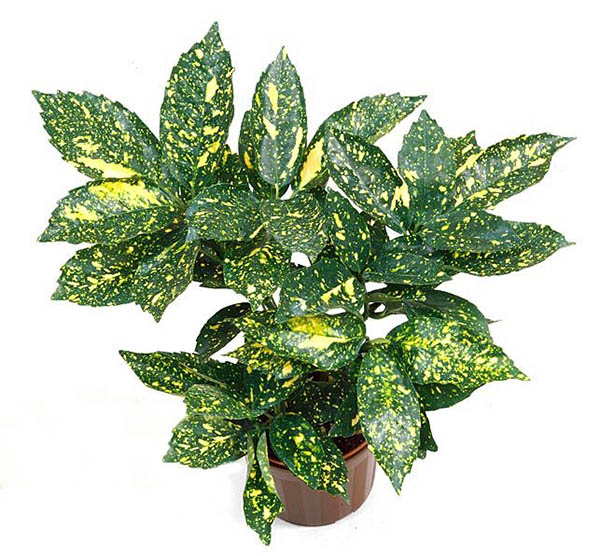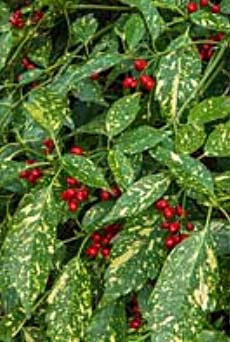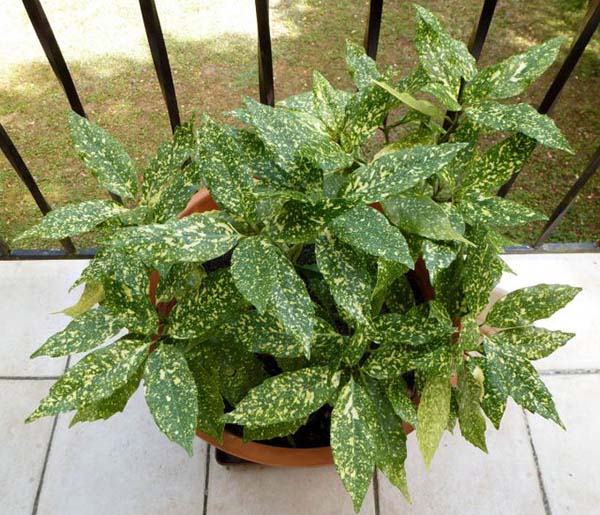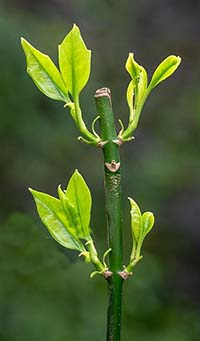Gold Dust Plant - Aucuba japonica
Aucuba (Aucuba) is a genus of plants in the Garryaceae family. Species of the Aucuba genus are found in China, Korea, and Japan. These are evergreen shrubs or small trees with shiny, leathery leaves, resembling laurels.

In domestic settings, Japanese Aucuba (Aucuba japonica) is commonly grown. This plant is also known as Japanese laurel, spotted laurel, Gold Dust Plant or golden tree. Aucuba leaves have yellow or orange spots and patches. In China and Japan, Aucuba is often found in gardens, cultivated for centuries, resulting in numerous varieties with shiny leaves.

Gold Dust Plant leaves are leathery, shiny, arranged oppositely, elongated-oval in shape, up to 20 cm long and 6 cm wide, with a rounded base and pointed tip, dark green with yellow or orange spots of various sizes. In the upper part of the leaf, 2-4-6 pairs of teeth are often present. The peculiar coloring of the leaves has led to the name "Golden Dust."
Aucuba japonica varieties include both male and female plants that produce clusters of tiny purplish flowers in spring. They're not very attractive but if pollinated, the flowers are followed by bright red berries carried on the plant through the winter. Indoor it rarely blooms.
Special Care for Aucuba Japonica
Care Tips for Aucuba Aucuba is an easy-to-care-for indoor plant, with one notable requirement – it needs to winter in cool conditions.
Light: The golden tree thrives in shaded areas. Bright light should be diffused. It is not recommended to place variegated forms on north-facing windows, as their leaves will lose their beautiful pattern in such conditions.
Temperature: Cool (45-65°F/7-18°C) temperatures year-round suit this Japanese laurel just fine. In fact, it can tolerate cold -- down to 5°F/-15°C -- and is sometimes grown as an outdoor shrub. If it gets too hot indoors, Aucuba will shed its beautiful leaves. In spring and summer, you can move the pot with Aucuba outdoors, choosing a shaded spot.

Water: Keep the soil consistently moist from spring to autumn. Reduce watering in winter when growth slows down. Waterlogged soil is undesirable, as it can lead to root rot and black spots on the leaves. Use a pot with good drainage.
Humidity: Spray the golden tree only when the indoor air is very dry and the heating system is active.
Fertilizer: Fertilize Aucuba from early spring to late summer once a week. During the cool wintering period, the plant goes into a "sleep" and does not need additional nutrients.
Pruning: Pruning is necessary for Gold Dust Plant to maintain a neat and tidy crown. It is customary to prune the bush with the arrival of spring. Do not rush to discard pruned branches; they can be used for propagation.
Soil: A mixture of leafy soil, garden soil, peat, and river sand is suitable. Universal soil mix for indoor plants can also be used.
Repotting: Choose wide, stable pots for Gold Dust Plant, with a drainage layer at the bottom. Repotting should be done very carefully to avoid damaging the delicate roots. Golden laurel initially grows quickly, then the growth slows down. Until Aucuba reaches 5 years old, it should be repotted every year. Adult plants are repotted only if the root system outgrows the container. Repotting should be done carefully to avoid damaging the delicate roots.

Propagation: Cuttings for Gold Dust Plant propagation are best taken from the top of last year's shoots. Ensure that each cutting has a minimum of three leaves. Root the cuttings in a peat-sand mixture or simply in river sand. Cover the containers with a lid and place them in a warm place, remembering to ventilate and water the seedlings periodically. Once the cuttings have developed roots, transplant them into pots with a mixture of compost, peat, and sand.
Pests and Diseases: Aucuba has a strong immunity, but problems may arise with insufficient light and excessive watering. Spider mites and mealybugs are harmful pests that can be eliminated by treating the plant with insecticides.
Possible Problems in Growing Gold Dust Plant:
- Leaf discoloration: Occurs when the light level is too high.
- Loss of variegation: The bush is experiencing a lack of light.
- New leaves are too small: Insufficient nutrients. You may be forgetting to fertilize the plant.
- Premature leaf drop: The indoor air is too dry, or it is too hot.
- Yellowing leaves: Disrupted watering or temperature fluctuations.
- Leaf edges dry: This is caused by wintering the bush in conditions of too low air humidity.
- Spots on leaves: Dark spots on leaf blades result from wintering in a room with excessively dry and warm air. Another possible cause is too much water in the pot."




